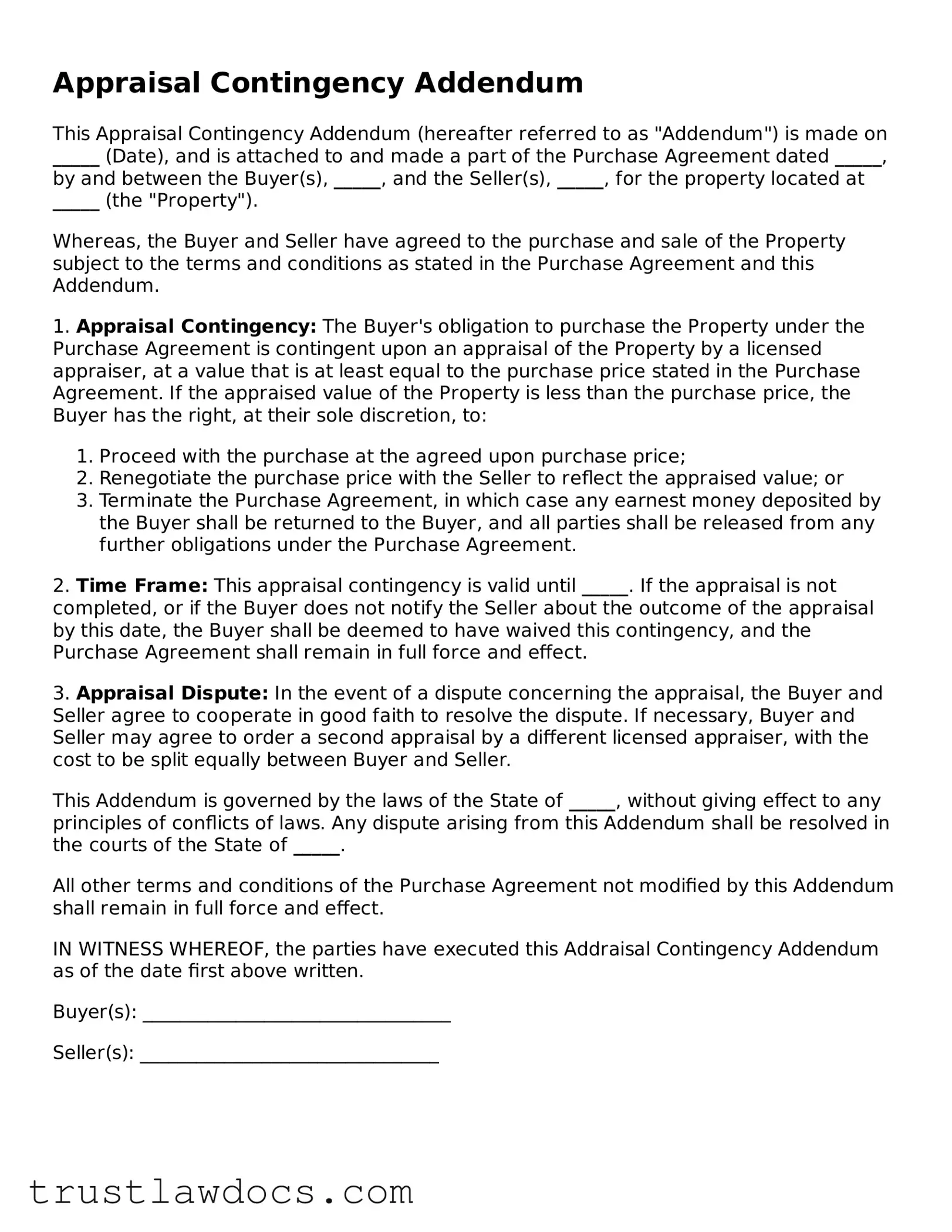What is an Appraisal Contingency Addendum?
An Appraisal Contingency Addendum is a document added to a real estate purchase agreement. It states that the buying of the property is contingent upon the property being appraised at a minimum specified amount. This clause protects the buyer, ensuring they are not obligated to proceed with the purchase if the valuation doesn't meet the expected price, which could affect the loan amount the bank is willing to lend.
When should an Appraisal Contingency Addendum be used?
This addendum should be considered when making an offer on a property. It is especially important in markets where property values can fluctuate rapidly, or if the buyer feels there might be a risk of the property appraising for less than the offer price. Including this addendum in the purchase agreement gives the buyer a way to back out of the contract without penalty if the appraisal is not satisfactory.
How does an Appraisal Contingency work?
Once included in a real estate purchase agreement, an appraisal contingency clause requires that a licensed appraiser assess the value of the property. If the appraised value is less than the specified amount in the contingency, the buyer has the option to cancel the contract or negotiate a lower purchase price. Typically, there's a specified period in which the buyer must notify the seller of their decision.
Can a seller refuse to accept an offer with an Appraisal Contingency Addendum?
Yes, sellers can refuse an offer that includes an appraisal contingency, as they might perceive it as a potential hurdle to closing the deal. However, it's also common for sellers to accept such offers, especially in a buyer's market or if they are confident in their property's value meeting the appraisal expectations.
Is it possible to waive the Appraisal Contingency Addendum?
Yes, a buyer can waive the appraisal contingency to make their offer more appealing to the seller, especially in a competitive market. However, waiving this contingency means the buyer may have to cover the difference if the property appraises for less than the offer price, which can involve a significant amount of additional funds.
What are the risks of waiving an Appraisal Contingency?
Waiving an appraisal contingency can be risky. If the appraisal comes back lower than the purchase price, the buyer may not secure a loan for the full purchase amount. This means the buyer would need to pay the difference out of pocket or risk losing the property and any earnest money deposited. It's a decision that should not be taken lightly and usually requires careful financial planning.
What happens if the appraisal is higher than the purchase price?
If the appraisal comes in higher than the purchase price, the appraisal contingency is typically considered satisfied, and the sale proceeds as planned. The buyer will not receive any direct financial benefit from the higher appraisal, but they can gain equity in the home from the start, which is a positive outcome.
Can a buyer renegotiate the purchase price based on the appraisal?
Yes, if the appraisal comes in lower than the purchase price and there is an appraisal contingency in place, the buyer can use this as leverage to renegotiate the purchase price with the seller. However, the seller is not obligated to lower the price, and it may lead to further negotiations or the cancellation of the purchase agreement if both parties cannot agree.
What should be done if the appraisal falls short of the contingency amount?
If the appraisal falls short of the contingency amount, the buyer has several options, depending on the terms of the contract. These can include negotiating a lower purchase price with the seller, paying the difference between the appraised value and the purchase price, or exercising the right to back out of the purchase agreement if the two parties cannot reach an agreement. It's critical for the buyer to communicate their decision within the timeframe specified in the contract.
How is the minimum specified appraisal value determined?
The minimum specified appraisal value is typically determined through mutual agreement between the buyer and seller at the time of the offer and is based on factors such as recent sales of similar properties in the area, the property's condition, and current market conditions. It's a strategic figure that requires careful consideration to protect the buyer's interests while making the offer appealing to the seller.
